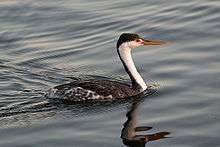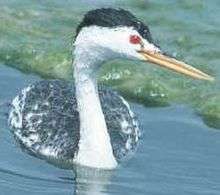Clark's grebe
| Clark's grebe | |
|---|---|
 | |
| Nonbreeding plumage | |
| Scientific classification | |
| Kingdom: | Animalia |
| Phylum: | Chordata |
| Class: | Aves |
| Order: | Podicipediformes |
| Family: | Podicipedidae |
| Genus: | Aechmophorus |
| Species: | A. clarkii |
| Binomial name | |
| Aechmophorus clarkii (Lawrence, 1858) | |
Clark's grebe (Aechmophorus clarkii) is a North American species in the grebe family. Until the 1980s, it was thought to be a pale morph of the western grebe, which it resembles in size, range, and behavior. Intermediates between the two species are known.
The "Clark" of its common name—and its specific epithet clarkii—honors John Henry Clark, a 19th-century American surveyor who was also a naturalist and collector.[2] The genus name Aechmophorus comes from the Ancient Greek words "aichme", meaning spear, and "phoros", meaning someone who bears things around; it refers to the bird's long, daggerlike beak.
This species nests on large inland lakes in western North America and migrates to the Pacific coast in winter. It maintains local populations year-round in California, Nevada, and Arizona (the Lower Colorado River Valley), as well as in central Mexico. It feeds by diving for carp, herring, mollusks, crabs, and salamanders.
It performs the same elaborate courtship display as the western grebe.
Description

Clark's grebe is black-and-white and has long slender neck. It ranges in size from 22–29 inches (56–74 cm). Among its distinguishing features is its bill, which is slightly upturned and bright yellow, whereas the western grebe's bill is straight and greenish-yellow. It shows white around its eyes, whereas black appears around the eyes of the western grebe. The downy young are white, not gray.
Subspecies
There are two subspecies of Clark's grebe:
- A. c. clarkii, (Lawrence, 1858), north & central Mexico
- A. c. transitionalis, (Dickerman, 1986), western Canada & western United States
Gallery
-

Breeding plumage
-

On nest
References
- ↑ BirdLife International (2012). "Aechmophorus clarkii". IUCN Red List of Threatened Species. Version 2013.2. International Union for Conservation of Nature. Retrieved 26 November 2013.
- ↑ Beolens, Bo; Michael Watkins (2003). Whose Bird?. Christopher Helm. p. 84. ISBN 0-7136-6647-1.
Ratti, J.T., 1979. Reproductive separation and isolating mechanisms between dark- and light-phased grebes. Auk 96:573-586.
External links
- Clark's Grebe videos on the Internet Bird Collection
- Clark's Grebe photo gallery VIREO
- "Aechmophorus clarkii". Integrated Taxonomic Information System. Retrieved 24 February 2009.
